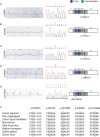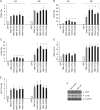TBX5 mutations contribute to early-onset atrial fibrillation in Chinese and Caucasians
- PMID: 26762269
- PMCID: PMC4752043
- DOI: 10.1093/cvr/cvw003
TBX5 mutations contribute to early-onset atrial fibrillation in Chinese and Caucasians
Abstract
Aims: Atrial fibrillation (AF) is a common arrhythmia with an important heritable aspect. The genetic factors underlying AF have not been fully elucidated.
Methods and results: We screened six candidate genes (CAV1, KCNJ2, KCNQ1, NKX2.5, PITX2, and TBX5) for novel mutations in 139 patients of Chinese descent with early-onset AF and 576 controls. Four missense TBX5 mutations, p.R355C, p.Q376R, p.A428S, and p.S372L, were identified in evolutionarily conserved regions. We did not find any mutations in CAV1, KCNJ2, KCNQ1, NKX2.5, and PITX2. These mutations increased the expression of atrial natriuretic peptide (ANP) and connexin-40 (CX40) in the primarily cultured rat atrial myocytes but did not alter the expression of cardiac structural genes, atrial myosin heavy chain-α (MHC-α) and myosin light chain-2α (MLC-2α). Overexpression of p.R355C developed an atrial arrhythmia suggestive of paroxysmal AF in the zebrafish model. To replicate our findings, we screened TBX5 in 527 early-onset AF cases from the Massachusetts General Hospital AF study. A novel TBX5 deletion (ΔAsp118, p.D118del) was identified, while no TBX5 mutations were identified in 1176 control subjects.
Conclusion: Our results provide both genetic and functional evidence to support the contribution of TBX5 gene in the pathogenesis of AF. The potential mechanism of arrhythmia may be due in part to the disturbed expression of ANP and CX40.
Keywords: ANP; Atrial fibrillation; Connexin; Mutation; TBX5.
Published on behalf of the European Society of Cardiology. All rights reserved. © The Author 2016. For permissions please email: journals.permissions@oup.com.
Figures



References
-
- Wolf PA, Abbott RD, Kannel WB. Atrial fibrillation: a major contributor to stroke in the elderly. The Framingham Study. Arch Intern Med 1987;147:1561–1564. - PubMed
-
- Schnabel RB, Sullivan LM, Levy D, Pencina MJ, Massaro JM, D'Agostino RB Sr, Newton-Cheh C, Yamamoto JF, Magnani JW, Tadros TM, Kannel WB, Wang TJ, Ellinor PT, Wolf PA, Vasan RS, Benjamin EJ. Development of a risk score for atrial fibrillation (Framingham Heart Study): a community-based cohort study. Lancet 2009;373:739–745. - PMC - PubMed
-
- Go AS, Hylek EM, Phillips KA, Chang Y, Henault LE, Selby JV, Singer DE. Prevalence of diagnosed atrial fibrillation in adults: national implications for rhythm management and stroke prevention: the AnTicoagulation and Risk Factors in Atrial Fibrillation (ATRIA) study. JAMA 2001;285:2370–2375. - PubMed
-
- Feinberg WM, Blackshear JL, Laupacis A, Kronmal R, Hart RG. Prevalence, age distribution, and gender of patients with atrial fibrillation. Analysis and implications. Arch Intern Med 1995;155:469–473. - PubMed
-
- Chugh SS, Blackshear JL, Shen WK, Hammill SC, Gersh BJ. Epidemiology and natural history of atrial fibrillation: clinical implications. J Am Coll Cardiol 2001;37:371–378. - PubMed
Publication types
MeSH terms
Substances
Grants and funding
LinkOut - more resources
Full Text Sources
Other Literature Sources
Medical
Molecular Biology Databases
Research Materials

